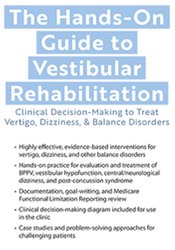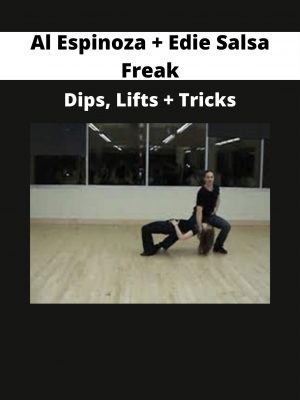Colleen Sleik – The Hands-On Guide to Vestibular Rehabilitation: Clinical Decision-Making to Treat Vertigo, Dizziness, & Balance Disorders
$219 Original price was: $219.$62Current price is: $62.
Shopping Instructions:
- DISCOUNT 15% : SHOP15
- Product Delivery: Within 1 – 12 hours after purchase.
However, the care becomes much more complex for patients that are experiencing something that was initially thought to be BPPV or for those who have multiple conditions impacting their overall presentation.
Colleen Sleik – The Hands-On Guide to Vestibular Rehabilitation: Clinical Decision-Making to Treat Vertigo, Dizziness, & Balance Disorders
ASSESSMENT TECHNIQUES FOR DIFFERENTIAL DIAGNOSIS
- Position modifications for patients with mobility limitations or in environments with limited space such as home health or acute care
- Clinical decision-making large group activity to apply assessment techniques and interpret findings
- Recognize assessment findings that indicate central, peripheral, and cervicogenic dizziness diagnoses
- Determine a therapy diagnosis based on patient history, onset, symptoms and assessment
MEDICAL DIAGNOSES AND PROGNOSIS: PERIPHERAL & CENTRAL ORIGIN
- Benign Paroxysmal Positional Vertigo
- Vestibular neuronitis, labyrinitis
- Meniere’s disease, endolymphatic hydrops, acoustic neuroma
- Central vertigo: CVA, multiple sclerosis, migraine-associated
- Cervicogenic vertigo
- Post-concussion syndrome
- Sensory integration/Multi-factorial balance dysfunction
EXAM LAB
- Clearing cervical spine: mVAT, Sharp-Purser test
- Occulomotor exam: Smooth pursuit, Saccades, Vergence and visual acuity
- Vestibular exam: Head thrust, Head-Shaking Nystagmus, Hallpike-Dix, Roll Test
- Assessing nystagmus: Horizontal, vertical, torsional
- Motion sensitivity quotient
- Balance assessment: mCTSIB, Dynamic Gait Index, Gait
VESTIBULAR REHABILITATION: DEVELOPING A PATIENT-SPECIFIC TREATMENT PLAN
- Canalith repositioning maneuvers: Epley maneuver, BBQ roll / quick BBQ roll, Cassani, Appiani, Brandt-Daroff Exercises
- Gaze stabilization: Basic and advancements
- Balance progression
- Sensory integration in balance Evidence-based Functional Assessment Tools
- Vestibular EDGE recommendations from the Academy of Neurologic Physical Therapy
- Direct each of the 4 areas of treatment for vestibular rehabilitation
Would you like to receive Colleen Sleik – The Hands-On Guide to Vestibular Rehabilitation: Clinical Decision-Making to Treat Vertigo, Dizziness, & Balance Disorders ?
Description:
Colleen Sleik PT, DPT, OCS, NCS, began her journey into the specialized care of vestibular rehabilitation patients after evaluating a patient that she felt ill equipped to help. She needed to know more. Recognizing and treating BPPV itself is quite straightforward.
However, the care becomes much more complex for patients that are experiencing something that was initially thought to be BPPV or for those who have multiple conditions impacting their overall presentation. Advanced learning is required to understand how the systems function as a whole. This course was developed with these challenging patients in mind.
The recording begins with assessment and treatment techniques for BPPV, including a lab component to practice technique, hand positioning, and patient-specific modifications. You will become skilled to better recognize BPPV and subsequently recognize the presentations that do not fit the BPPV pattern. Further assessment and treatment of the non-BPPV diagnoses will also be addressed through functional assessments and treatment progressions.
Participants of this course will walk out with a deeper understanding of assessment, treatment techniques, patient-specific modifications, and differential diagnosis skills for the dizzy patient. Take your skills to a new level when you can pinpoint the areas where therapy can intervene to promote the desired functional gains for patients and the strategies to appropriately progress patients through each of those areas.
Here’s What You’ll Get in Colleen Sleik – The Hands-On Guide to Vestibular Rehabilitation: Clinical Decision-Making to Treat Vertigo, Dizziness, & Balance Disorders
Colleen Sleik – The Hands-On Guide to Vestibular Rehabilitation: Clinical Decision-Making to Treat Vertigo, Dizziness, & Balance Disorders : Sample
Related products
Other Courses
Other Courses
Other Courses
Other Courses
Other Courses
Other Courses
Other Courses
Other Courses













